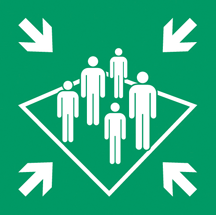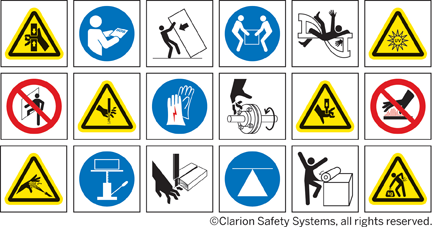In this column, we’ll explore the need for standardized elements and components in symbols in order to effectively communicate safety.
As a professional in the engineering field, a primary concern you’re faced with is effectively communicating safety. Often that involves the customization of safety labels and markings for the products you design or manufacture. To communicate your specific safety or hazard information, graphical symbols are critical. Why? Well-drawn symbols have the ability to command attention and engage viewers in a way that words alone simply cannot match – and they do so in a way that globally communicates your message across language barriers.
When you see a symbol, whether it’s a notice in a public setting or a warning on a product, at first glance it looks simple. That’s because, when a symbol is well-designed, its end result should look simple; it should be easy to understand either due to its clear representational elements, or because you “learned” to recognize it through its consistent use and through repeated exposure.
But, when it comes to how a standardized symbol is created, how it came to have its precise appearance and design elements, it’s anything but a simple process. It is not a process characterized by expert designers each doing their own thing to invent new symbols. Standardized elements and components must be used in order to yield symbols that are consistent in their construction and readily understood. And, that’s what this column is about. There’s a science behind symbol design. It involves the careful application and consideration of three important factors: 1) an understanding of the latest global safety standards, 2) a high regard for best practice symbol design principles, and 3) as complete a knowledge as possible of the symbols that have been standardized to date.
Graphical symbols are standardized worldwide by two global groups, ISO and IEC. When it comes to safety symbols, ISO is the one to watch, in particular, ISO Technical Committee 145 committee. In my work in chairing the U.S. Technical Advisory Group to ISO/TC 145 – Graphical Symbols, I’ve been involved in an effort to define best practices for shipboard safety sign systems. This is part of a nearly 3-year-long project that will usher in a new era of visual safety communication onboard ships. (See the April 2012 On Your Mark column, which refers to the overturned Costa Concordia cruise ship, for more information on safety sign systems onboard ships.) The goal of the specific committee that I’m working with is to reevaluate symbols currently in use onboard ships, with the intention of modernizing them in line with ISO/TC 145 graphical design principles. To illustrate the importance of using standardized elements and components in symbols, let’s look at a few examples of these shipboard safety symbols, which are now in their final stages of development.
Figure 1 shows an old and new version of an assembly point symbol, the icon used to guide a ship’s passengers to the location of assembly stations. The older version is too visually complex for quick understanding by a first-time viewer, and it fails to use the latest ISO design principles for the human figure and arrow elements. In contrast, in the new version, the design has been simplified to be visually ‘legible’ from a greater distance, and it has been updated to use human figures and arrows that comply with ISO symbol design principles, principles that have been used to create an entire vocabulary of new symbols, including those shown in Figure 2.


Figure 1: Old (at left) and new (at right) images of the shipboard assembly point symbol.



Figure 2: A selection of ISO symbols that share common design features with the new assembly point symbol.
Figure 3 shows an old and new version of a radiotelephone symbol, the icon used to guide a ship’s crew to the location of a two-way VHF radiotelephone apparatus. The older version does not use the latest ISO design element for “waves,” as shown in the non-ionizing radiation symbol in Figure 4. The new version utilizes this wave pattern, using the same line thickness and shape consistent with this element as its been visually represented in other recent ISO symbols.


Figure 3: Old (at left) and new (at right) images of the radiotelephone symbol.

Figure 4: The ISO symbol for non-ionizing radiation.
Now, how can this help to guide your product safety labels? When it comes to properly creating new symbols, you don’t need to – and shouldn’t – reinvent the wheel. No matter what type of hazard message or safety information you need to convey, you should use what’s been done before in symbol standardization to guide your efforts if and when a new symbol needs to be created. Figure 5 shows a wide range of symbols that Clarion has created as part of its work in helping companies to better communicate safety so risk is reduced and people are better protected from harm.

Figure 5: Clarion-created safety symbols, crafted with ISO design principles to aid in noticeability and comprehension.
Images courtesy of Clarion Safety Systems ©2012, all rights reserved.
For more information about safety signs and symbols, visit www.clarionsafety.com. ![]()
 |
Geoffrey Peckham is President of Clarion Safety Systems and chair of both the ANSI Z535 Committee and the U.S. Technical Advisory Group to ISO Technical Committee 145- Graphical Symbols. Over the past two decades he has played a pivotal role in the harmonization of U.S. and international standards dealing with safety signs, colors, formats and symbols. This article is courtesy of Clarion Safety Systems © 2012. All rights reserved. Clarion strongly protects its intellectual property rights, including sign designs. |
